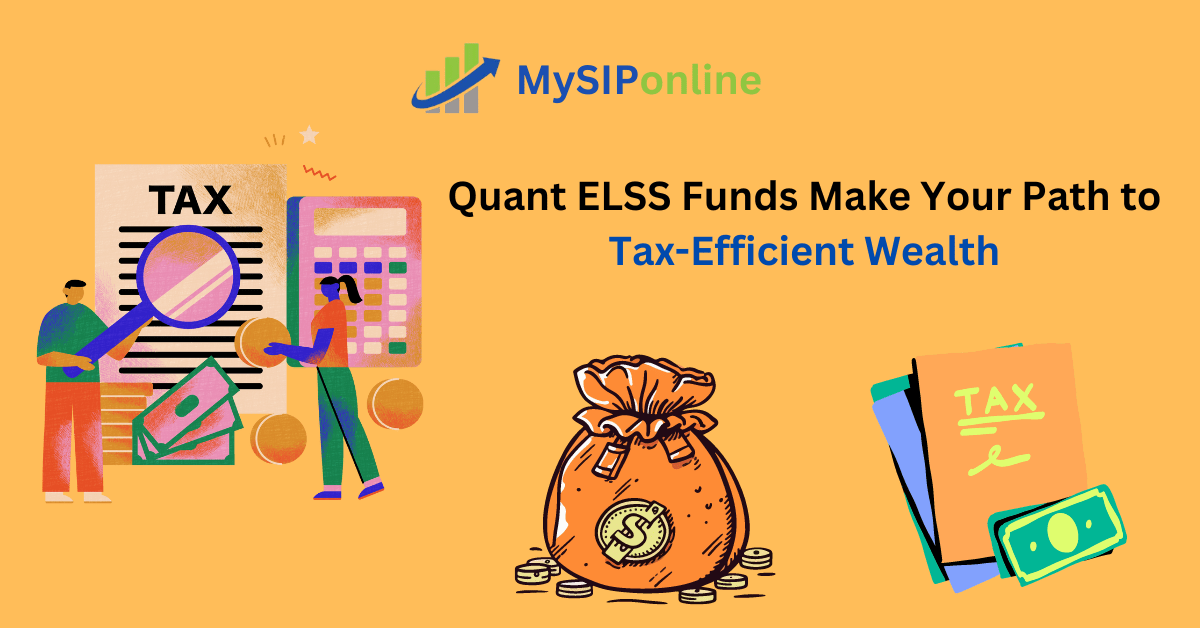Introduction
Investing may seem a bit complex process at first, but the more we understand it becomes easy. Likewise, the Quant ELSS Funds is a feasible choice if we look at the current market performance of this fund. Before we get into the details of this fund, let’s identify its category.
This fund falls under the ELSS category, which is specially built to save investor’s taxes. Quant ELSS Tax Plan is an equity-linked fund scheme, offering various benefits to reduce one’s tax liabilities.
This fund scheme was launched on 1st April 2000 & has generated 24.37% returns in the past three years.
In this article, we will explore the objective of this scheme & what investors would have achieved by investing in it. It is a comprehensive guide that will show us that this scheme is the best option in the current market scenario. Let us start our analysis by learning the fund’s goals and purpose.
Learning the Fund’s Objective
Capital Appreciation Focus
The scheme’s principal purpose is capital appreciation. This means that the fund’s goal is to gradually grow the value of its owners’ capital through strategic investments.
Diversified Portfolio
The scheme invests in a diverse range of equity shares. Diversification helps to spread investment risk among numerous companies, sectors, and market segments. It results in lessening the impact of negative occurrences on the entire portfolio.
Emphasis on Growth Potential
Investments are made in equity shares with high growth potential. This means that the fund management selects stocks of firms that are likely to expand. In terms of earnings, sales, or market share, potentially leading to an increase in stock prices.
Potential Dividend Income
In addition to capital appreciation, investors may receive dividend income. Dividends are a percentage of a company’s profits paid out to shareholders, providing investors with an additional source of income.
Consideration of Other Revenue Sources
In addition to dividends, the program takes into account other potential sources of revenue. These could include interest income from fixed-income securities. Also capital gains from the sale of assets, and other types of investment income.
Long-Term Growth Opportunities
The fund is dedicated to identifying long-term growth opportunities in the equities market. This suggests that investments are made with a longer time horizon than short-term swings. It is in line with investors’ long-term financial aspirations.
Balanced Approach
The investing aim demonstrates a balanced approach to meeting investor goals. By stressing both capital appreciation and income creation, the scheme seeks to meet the different needs of investors. Regardless of whether they favour growth or income.
What are the pros & cons of investing in Quant ELSS Tax Plan?
Investing in a Quant ELSS Tax Plan has several advantages and disadvantages. Let us delve into them:
Let’s discuss the advantages of investing in this Fund scheme:
Tax Benefits
One of the key benefits of investing in a Quant ELSS Tax Plan is that it provides tax breaks under Section 80C of the Income Tax Act. Investing in ELSS funds allows investors to deduct up to ₹1.5 lakh from their taxable income, decreasing overall tax obligation.
Potential for Higher Returns
ELSS funds use quantitative methodologies to uncover cheap or high-growth stocks through data-driven analysis. This technique has the potential to deliver larger long-term returns than standard investing ways.
Professional Management
Quantitative ELSS Tax Plans are handled by skilled fund managers and quantitative analysts. They use complex algorithms and models to make investment choices. This professional expertise can assist optimize your portfolio.
Diversification
ELSS funds usually include a diverse portfolio of equities from various industries and market capitalizations. This diversity serves to disperse risk and mitigates the impact of bad occurrences on the total portfolio.
Lock-in Period
ELSS funds need a three-year lock-in period, which encourages disciplined investment and discourages early withdrawals. This lock-in period encourages investors to stay invested for the long term, which is consistent with the wealth development goals.
Now that we know the pros of investing in this scheme, let’s take a quick look at the disadvantages.
Market Volatility
As with other equity-based investments, Quant ELSS Funds are open to market volatility. Stock price fluctuations can influence fund performance. It can result in times of negative returns, particularly in the short term.
Lack of Flexibility
These funds have a three-year obligatory lock-in period. This means investors cannot redeem their assets before it expires. This lack of flexibility may not be appropriate for those seeking cash or those with short-term financial goals.
Fund Manager’s Profile
Mr Ankit Pande (equity fund manager)
Mr Ankit Pande is the head of equity and has more than 10 years of expertise in Indian stocks. He is regarded as one of the best money managers in the mutual fund industry. His career began with Infosys, where he developed banking software. Ankit received recognition in 2014 when he won the Thomson Reuters StarMine Analysts award for being the best “Industry Stock Picker” in the Information Technology sector during his tenure as a technology analyst.
Who should invest?
For analytical thinkers
Quant mutual funds may be an appropriate alternative for individuals who value making decisions based on numbers and mathematics. This strategy for investing is based on data analysis and quantitative methodologies. This may appeal to those who appreciate such strategies.
For Risk Takers
Although quant mutual funds prioritize risk control, it is important to note that all investments include some amount of risk. When evaluating these funds, check that the investor’s risk tolerance matches the fund’s risk management techniques.
For diversification enthusiasts
Quant mutual funds are distinguished by investing across a wide range of assets and sectors. Choosing these funds can give investors a wide range of investing alternatives. It reduces risk through portfolio diversification.
Conclusion
In conclusion, investing in Quant ELSS Funds has various advantages, including tax reductions. The possibility for better returns, expert management, diversification, and a disciplined investment approach throughout the lock-in period. However, investors should be careful of market volatility. A lack of flexibility according to the lock-in period, and confirming that their risk tolerance matches the fund’s policies.
Given these considerations, Quant ELSS Tax Plans may be appropriate for analytical thinkers. They value data-driven decision-making and risk-takers who understand and agree with the fund’s risk management strategy. The diversification supporters want exposure to a diverse variety of assets and industries.
Overall, Quant ELSS Tax Plans provide possibilities for tax-efficient wealth growth. Offering a Systematic Investment Plan promotes a disciplined approach to investing.






